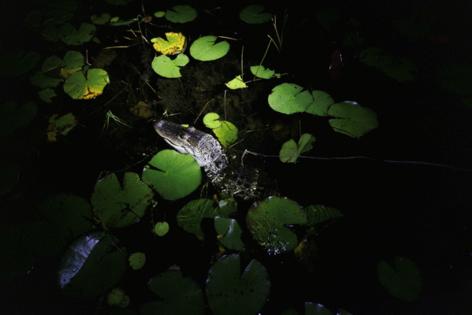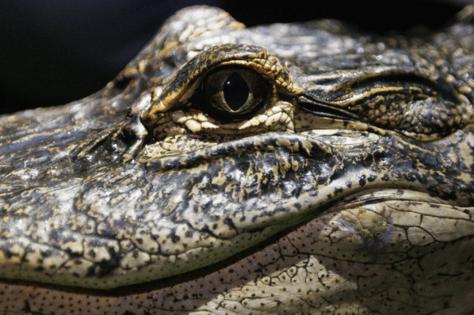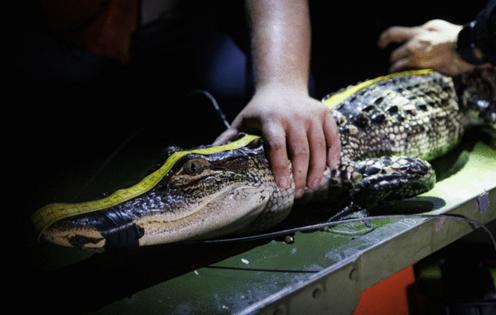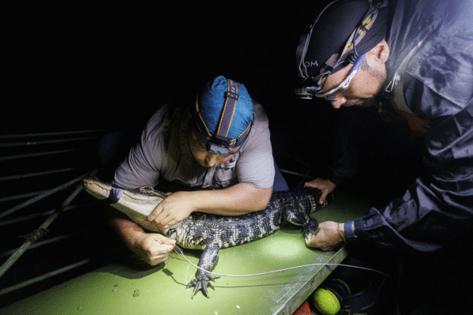How will climate change impact Florida's Everglades? Gators may be a key gauge
Published in News & Features
MIAMI — A bright searchlight pierces the darkness as the 18-foot airboat glides across the Everglades, the beam igniting small sparkling shimmers in the ink-black water dotted with lily pads.
Glowing gator eyes — the tell-tale reflections of lurking reptiles.
Alligators like to hunt in the dark but tonight they’re the creatures being stalked — not for sport but for science by two University of Florida wildlife biologists, Sergio Balaguera-Reina and Kevin Olejiczak.
Alligators, along with their cousins and co-residents crocodiles, are sensitive to environmental changes in the Everglades. That makes them what scientists call a good “indicator species” for assessing progress in the on-going multibillion-dollar effort to restore the natural water flow to the sprawling River of Grass. Gators are a bit like Goldilocks. Too much water, and they use too much energy trying to catching fish and other prey. Not enough, and they struggle to move or mate. They need the water just right.
For researchers, the big reptiles also have become a gauge of one of the biggest threats to the future of the Everglades — climate change. Sea rise, higher temperatures, wetter hurricanes, those are all factors that will alter the assorted ecosystems that comprise the greater Everglades in the coming decade.
The two biologists are part of the UF “Croc Docs” team that has documented erosion changing nesting patterns of the threatened North American crocodile along the coast of the southern Everglades and in Florida Bay since the ‘70s. Balaguera-Reina believes climate change will only hasten the loss of nesting habitat.
“Some of the islands that we have visited before and saw nesting, now we see nothing because it’s just covered with water,” Balaguera-Reina said. “We know climate change is affecting other species, so we need to get ready to see how it affects the species we have here in the Everglades.”’
The data collected on trips like this will help draw a clearer picture of how gators and crocs will adapt — or not.
Catching and subduing a gator in the wild and can be a challenge (and requires a state research or hunting permit so don’t think about it). As Balaguera-Reina steered, Olejiczak handled a pole tipped with a wire-noose snare. Gators do not have big brains — it’s often been compared in size to a walnut —but they do have ancient instincts. Some wary beasts torpedoed under the boat as they were approached. But after nearly an hour on the water, the scientists snared the first one.
“She’s not happy,” Balaguera-Reina said as the alligator splashed and turned over and over in what’s known as a death roll — the death part typically the result for anything clamped in its powerful jaws.
After wrapping black electric tape four times around the jaws, the biologists hoisted the gator aboard — a five-and-half-foot female weighting 35 pounds. Balaguera-Reina estimated it could be about 10 years old.
While speeding across the marshes and canal bordering Tamiami Trail, Balaguera-Reina noted there were fewer gators in the area than last year, which he thinks is because this year the water is deeper from heavy rainfall this year. There are no crocs this far north in the Everglades. Most of the much rarer North American crocodile live in the salty coastal zones fringing Florida Bay and the Gulf of Mexico.
During a trip that covered 20 miles in the Francis S. Taylor Wildlife Management Area near the Miccosukee Tribe reservation, the biologists eventually caught, weighed, measured and examined two females. The information from this night’s trip will be shared with the federal and state agencies that are partners in the massive plumbing project to restore the Everglades.
That work has been going on for decades and will continue for more — removing and filling old canals, constructing giant reservoirs, adding pumps and artificial marshes to clean polluted farm runoff. Bridges that open up the roadbed of the historic Trail have already been installed to handle more water flow to the south.
It will take years more before gators and crocs tell the story about how well all these projects have worked. Fixing the devastation caused by drainage and development is daunting and some areas still struggle with conditions that are too wet or too dry at the wrong time. Water flows and depths rise and fall depending on the season and dictate the mating and feeding patterns of the reptiles, along with wading birds and other species.
“We are not there yet with getting that balance of where we need to have the water to achieve our ecological objectives,” said Laura Brandt, a wildlife biologist with U.S. Fish and Wildlife.
How climate will influence crocs and gators remains an on-going study. Brandt said scientists are working on including climate change impacts in their projection models. “We recognize we need to do that,” she said.
Brandt believes the impacts on their survival could be subtle because unlike plants, alligators and crocodiles can move to new places.
Some studies already have indicated warming coastal waters may be pushing the reptiles to expand their range to the north. That could hint at “a new landscape” for alligators and crocs. But that’s not necessarily a good thing for their future if it means they are abandoning their historic habitat and nesting grounds because of coastal flooding to migrate to new higher ground.
“The concern is, where are they going to find those places?” she said. “And not all people are tolerant of crocodiles. Some of the places they might find are places that are higher elevation — which they’re higher elevation because there’s people living there.”
Ashley Miznazi is a climate change reporter for the Miami Herald funded by the Lynn and Louis Wolfson II Family Foundation in partnership with Journalism Funding Partners.
©2024 Miami Herald. Visit at miamiherald.com. Distributed by Tribune Content Agency, LLC.
















Comments